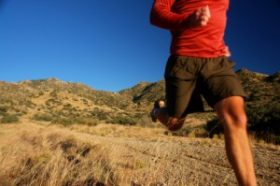Evolved to run
Heel bones hint that humans could run farther than Neandertals

Neandertals and ancient Homo sapiens probably did not compete against each other in track and field events, though we may never know for certain. But it’s tempting to consider, and a recent study gives us a way to bet on the winners of such a match-up.
Ancient Homo sapiens would probably have won long-distance races, while Neandertals might have dominated hilly courses and jumping events.
That’s because of the shapes of their heel bones, say a team of scientists from the University of Arizona in Tucson and Harvard University. Ancient Homo sapiens are humans who lived during the Stone Age. Like modern humans, these early people had short bones in the backs of their heels. The researchers say that these short heels stretched the Achilles tendons tight.
Tendons connect muscles to bones, and the Achilles tendon links the heel to the muscles in the calf. It’s the thickest and strongest tendon in the body, and it helps us walk, run and jump. (It’s also the tendon most likely to rupture, or break!) When you run, the tendon acts like a spring that stores energy as it stretches, and releases energy as it relaxes.
A tight tendon, say the scientists behind the new study, boosted that spring action and helped early human runners save energy, allowing them to run far. (We modern humans have the same-size heels as those early Homo sapiens, so next time you run a marathon, thank your heels.)
Not so with Neandertals. A separate species from Homo sapiens, Neandertals were also around during the Stone Age but are now extinct.
The scientists say members of that ancient species had taller heels than ancient Homo sapiens or modern people. So Neandertals probably pooped out faster, since their tendons required more energy. But a tall heel might have helped in other ways. The researchers hypothesize (hypothesize means to make an educated guess that can be tested) that tall heels supported Neandertals’ ankles, helping them walk uphill or jump.
Scientists already had a hunch that Neandertals weren’t good at long-distance running. Their bodies were shorter and stouter than those of modern people. Their inner-ear canals were smaller, too, which would have affected their balance.
The new study “provides a new line of evidence that Neandertals were not as adept at long-distance running as modern humans were,” Herman Pontzer told Science News. Pontzer is an anthropologist at Hunter College in New York City and did not work on the study. Anthropologists like Pontzer and David Raichlen, one of the scientists who did work on the study, want to understand humankind and its history.
Raichlen and his team first brought eight trained runners into the lab to run on treadmills. As the runners ran, the scientists measured how much oxygen they were using. Oxygen use can reveal how much energy the runners needed to keep up the pace, so the scientists ended up with a measurement of the energy use of the runners.
Next, the scientists measured the size of the volunteers’ heel bones using MRI, or magnetic resonance imaging, on their feet and lower legs. (An MRI uses magnetic fields to peek inside the human body.) The researchers used those images to connect energy use to heel size.
Then Raichlen and his team turned to the ancients. They reasoned that the Neandertals’ bodies probably worked the same way as the ancient humans’, so the connection between heel size and energy use should work for both people and Neandertals. The researchers studied measurements from the fossilized heel bones of 13 ancient Homo sapiens and six Neandertals that lived between 30,000 and 100,000 years ago. Using those measurements ― and using the work that matched energy use to heel size — the scientists found that Neandertals used more energy than the ancient people, when they ran at a constant speed.
Pontzer told Science News that why ancient people evolved to run farther than Neandertals remains a mystery. Many scientists suspect that ancient people in hot climates who could run for long stretches could chase prey to exhaustion — in which case long-distance running provided a way for people to eat.
POWER WORDS
(adapted from the Yahoo! Kids Dictionary)
anthropology The scientific study of the origin, the behavior, and the physical, social and cultural development of humans.
hypothesize To come up with a possible explanation for an observation, phenomenon or scientific problem that can be tested by further investigation.
Neandertals Humans’ closest relatives, members of an extinct species (Homo neanderthalensis) that lived throughout most of Europe and parts of Asia and northern Africa.
Achilles tendon The large tendon connecting the heel bone to the calf muscle of the leg.







